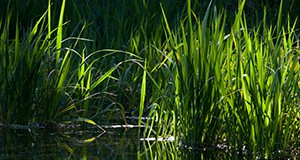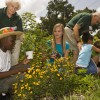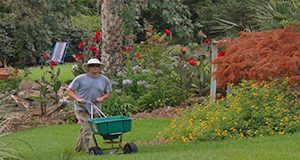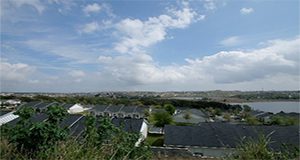This new 6-page document is intended to provide Floridians and their communities with information on a specific management practice in stormwater ponds: the use of fountains and other aeration approaches. These practices may provide opportunities both to improve water quality within the pond and protect downstream water quality. Specifically, this document gives basic information on fountains and the pros and cons of fountain installation and use. In addition, we provide information for pond managers or community decision makers on how to best manage ponds for effective pollutant removal in the pond and downstream water quality protection. Written by Samantha T. Howley, Steven P. Hohman, and Alexander J. Reisinger, and published by the UF/IFAS Department of Soil and Water Sciences.
https://edis.ifas.ufl.edu/ss695
Tag: Water Quality
Edible Landscaping Using the Nine Florida-Friendly LandscapingTM Principles
Maintaining edible landscapes in a way that protects the environment is an important concern for protecting Florida’s water quality. The objective of this new 7-page publication is to introduce the framework of the Florida-Friendly Landscaping™ principles and apply the principles to guide decisions about Best Management Practices (BMPs) for care of edible landscapes. Written by Tiare Silvasy, Lynn Barber, Esen Momol, Tina McIntyre, Tom Wichman, Gail Hansen, Jen Marvin, Terra Freeman, Joseph Sewards, Wendy Wilber, and Jacqlyn Rivas.
https://edis.ifas.ufl.edu/ep594
How to Properly Dispose of Unwanted Medications
Properly disposing of expired or unused medications can help reduce the prevalence of prescription drug abuse in Florida. It also helps prevent accidental ingestion by children or pets, helps prevent accidentally taking the wrong medication, and prevents medications from entering water sources. This new 3-page publication of the UF/IFAS Department of Soil and Water Sciences provides some dos and don’ts for disposing of your medications. Written by Alexander J. Reisinger.
https://edis.ifas.ufl.edu/ss680
Urban Fertilizer Ordinances in the Context of Environmental Horticulture and Water Quality Extension Programs: Frequently Asked Questions
Excess nitrogen (N) and phosphorus (P) in water bodies are a leading cause of water quality degradation statewide. More than 50 Florida counties and municipalities now have formal fertilizer ordinances, which in some cases include fertilizer blackouts, or bans on the usage of N and P fertilizers during certain times of the year. This 8-page document provides information on the underlying issues of fertilizer use, with an emphasis on an urban setting, and outlines the current state of the science on urban fertilizers and water quality in Florida. Written by Michael D. Dukes, Lisa Krimsky, Mary Lusk, Laurie Trenholm, Bryan Unruh, Michelle Atkinson, and Rao Mylavarapu, and published by the UF/IFAS Department of Agricultural and Biological Engineering, February 2020.
https://edis.ifas.ufl.edu/ae534
How Do Floridians Perceive Their Role in Protecting Water Quality and Quantity Through Landscape Practices?
Florida is faced with challenges in protecting both water quality and quantity; the state’s incredible number of home landscapes can positively or negatively impact water depending on how landscapes are managed. In 2016, Florida residents with irrigated landscapes were surveyed in order to create more effective Extension programs regarding landscape best management practices. This 4-page document discusses the results of this survey. Written by Laura A. Sanagorski Warner, Alexa J. Lamm, and Anil Kumar Chaudhary and published by the UF/IFAS Department of Agricultural Education and Communication, January 2018.
http://edis.ifas.ufl.edu/wc293
What Else Can Surface Water Buffer Systems Do?: Exploring Multiple Ecosystem Services
 As society confronts the consequences of global warming, deteriorating water quality, and impoverished biodiversity, there is a growing urgency to develop and expand water buffers' multifunctional ecosystem services. However, limited information is available on other potential co-benefits associated with the use of buffers, particularly VFSs. This 5-page fact sheet provides information on buffers' multiple ecosystem benefits, such as niche products production, carbon sequestration, and flood risk mitigation, as well as recommendations on future research needs necessary to enhance multiple ecosystem services and benefits of buffers. Written by Lei Wu, Rafael Muñoz-Carpena, and Yuncong Li, and published by the UF Department of Soil and Water Science, November 2015.
As society confronts the consequences of global warming, deteriorating water quality, and impoverished biodiversity, there is a growing urgency to develop and expand water buffers' multifunctional ecosystem services. However, limited information is available on other potential co-benefits associated with the use of buffers, particularly VFSs. This 5-page fact sheet provides information on buffers' multiple ecosystem benefits, such as niche products production, carbon sequestration, and flood risk mitigation, as well as recommendations on future research needs necessary to enhance multiple ecosystem services and benefits of buffers. Written by Lei Wu, Rafael Muñoz-Carpena, and Yuncong Li, and published by the UF Department of Soil and Water Science, November 2015.
http://edis.ifas.ufl.edu/ss647
Vegetative Filter Strips: A Best Management Practice for Controlling Nonpoint Source Pollution
 Increasing numbers of pollutants have been observed in natural water systems. As awareness of agricultural sources of water pollution has grown, Best Management Practices (BMPs) have been specifically designed to address agricultural water pollutants and protect water quality. This 4-page fact sheet introduces one of the BMPs, Vegetative Filter Strips (VFSs), which efficiently control nonpoint pollution such as sediments, nutrients, and pesticides. The publication covers primary functions, key design factors, and maintenance of VFSs. Written by Lei Wu, Rafael Muñoz-Carpena, and Yuncong Li, and published by the UF Department of Soil and Water Science, October 2015.
Increasing numbers of pollutants have been observed in natural water systems. As awareness of agricultural sources of water pollution has grown, Best Management Practices (BMPs) have been specifically designed to address agricultural water pollutants and protect water quality. This 4-page fact sheet introduces one of the BMPs, Vegetative Filter Strips (VFSs), which efficiently control nonpoint pollution such as sediments, nutrients, and pesticides. The publication covers primary functions, key design factors, and maintenance of VFSs. Written by Lei Wu, Rafael Muñoz-Carpena, and Yuncong Li, and published by the UF Department of Soil and Water Science, October 2015.
http://edis.ifas.ufl.edu/ss646
Socio-Demographic Characteristics and Concerns about Water Quality Issues of Master Gardener Program Volunteers
 To respond to residents’ informational needs, the Cooperative Extension Service offers a variety of volunteer training and certification programs. Who participates in such programs? What types of audiences are being reached? Do such programs increase knowledge and change behavior of the volunteers? In this article, we attempt to answer these questions by summarizing existing studies and using responses to a regional public survey, and by focusing on the Master Gardener program and surface water quality issues as examples. This 7-page fact sheet was written by Tatiana Borisova, Michael Smolen, Maria Pilar Useche, Jon Calabria, Nickola Sochacka, Damian Adams, Diane Boellstorff, Jason Evans, and Robert Mahler, and published by the UF Department of Food and Resource Economics, May 2014.
To respond to residents’ informational needs, the Cooperative Extension Service offers a variety of volunteer training and certification programs. Who participates in such programs? What types of audiences are being reached? Do such programs increase knowledge and change behavior of the volunteers? In this article, we attempt to answer these questions by summarizing existing studies and using responses to a regional public survey, and by focusing on the Master Gardener program and surface water quality issues as examples. This 7-page fact sheet was written by Tatiana Borisova, Michael Smolen, Maria Pilar Useche, Jon Calabria, Nickola Sochacka, Damian Adams, Diane Boellstorff, Jason Evans, and Robert Mahler, and published by the UF Department of Food and Resource Economics, May 2014.
http://edis.ifas.ufl.edu/fe942
Valuing the Ecosystem Services of Florida‹s Forest Conservation Programs: The Economic Benefits of Protecting Water Quality (FOR309/FR377)
 How much are Floridians willing to pay for water quality protection programs that include forest conservation? This 9-page fact sheet reports the results of a study to answer this question, using a benefit transfer approach. Written by Melissa M. Kreye, Francisco J. Escobedo, Damian C. Adams, Taylor Stein, and Tatiana Borisova, and published by the UF Department of School of Forest Resources and Conservation, April 2013.
How much are Floridians willing to pay for water quality protection programs that include forest conservation? This 9-page fact sheet reports the results of a study to answer this question, using a benefit transfer approach. Written by Melissa M. Kreye, Francisco J. Escobedo, Damian C. Adams, Taylor Stein, and Tatiana Borisova, and published by the UF Department of School of Forest Resources and Conservation, April 2013.
http://edis.ifas.ufl.edu/fr377
Conservation Subdivision: Construction Phase: Low Impact Development (LID) and Stormwater Treatment (WEC319/UW364)
 Because so much area in subdivisions is covered by impervious surfaces such as roads, buildings, and driveways, stormwater runoff must be accounted for and treated to prevent flooding and to remove contaminates. Often, stormwater runoff impacts surrounding landscapes and water bodies due to nutrient loading. In this 7-page fact sheet, we discuss the importance of using a more distributed stormwater treatment system that treats runoff closer to the source. Often called Low Impact Development (LID), this stormwater management approach is being used to more effectively remove pollutants from runoff. Written by Daniel Penniman, Mark Hostetler, and Glenn Acomb, and published by the UF Department of Wildlife Ecology and Conservation, March 2012.
Because so much area in subdivisions is covered by impervious surfaces such as roads, buildings, and driveways, stormwater runoff must be accounted for and treated to prevent flooding and to remove contaminates. Often, stormwater runoff impacts surrounding landscapes and water bodies due to nutrient loading. In this 7-page fact sheet, we discuss the importance of using a more distributed stormwater treatment system that treats runoff closer to the source. Often called Low Impact Development (LID), this stormwater management approach is being used to more effectively remove pollutants from runoff. Written by Daniel Penniman, Mark Hostetler, and Glenn Acomb, and published by the UF Department of Wildlife Ecology and Conservation, March 2012.
http://edis.ifas.ufl.edu/uw364
A Guide to EPA’s Numeric Nutrient Water Quality Criteria for Florida (SL316/SS528)
This revised 10-page guide provides a basic, concise, and understandable description of the United States Environmental Protection Agency’s (EPA) numeric nutrient criteria for Florida, the background events that led to its release, some pertinent scientific issues, and implications for the future. Written by Thomas Obreza, Mark Clark, Brian Boman, Tatiana Borisova, Matt Cohen, Michael Dukes, Tom Frazer, Ed Hanlon, Karl Havens, Chris Martinez, Kati Migliaccio, Sanjay Shukla, and Alan Wright, and published by the UF Department of Soil and Water Science, March 2011.
http://edis.ifas.ufl.edu/ss528
Evolution of water quality regulations in the United States and Florida (AE431)
Water is essential to sustain life. Not only do we all need a certain quantity of water each day, but the quality of the available water is also critical. Water quality protection in the United States evolved from initially ensuring navigability of waterways to protecting our natural ecosystems. This 5-page fact sheet provides a background for understanding water quality and how it is evaluated and regulated in the U.S. with particular focus on the state of Florida. Written by Kati W. Migliaccio, Yuncong Li, and Thomas A. Obreza. Published by the UF Department of Agricultural and Biological Engineering, January 2011.
http://edis.ifas.ufl.edu/ae431
SL316/SS528 A Guide to EPA’s Proposed Numeric Nutrient Water Quality Criteria for Florida
SL316, a 9-page illustrated guide by Thomas Obreza, Mark Clark, Brian Boman, Tatiana Borisova, Matt Cohen, Michael Dukes, Tom Frazer, Ed Hanlon, Karl Havens, Chris Martinez, Kati Migliaccio, Sanjay Shukla, and Alan Wright, provides a basic, concise, and understandable description of the United States Environmental Protection Agency’s (EPA) proposed numeric nutrient criteria for Florida, the background events that led to its release, some pertinent scientific issues, and implications for the future. Published by the UF Department of Soil and Water Science, February 2010.
http://edis.ifas.ufl.edu/ss528
SL275/SS490 Impact of Phosphorus on Water Quality
SL-275, a 4-page fact sheet by Rao Mylavarapu, highlights the role of phosphorus, interactions with the environment, and its potential impact on water quality. It is intended to serve audiences such as high school students, farmers, and the general public seeking information on the causes and mechanisms of potential phosphorus effects on water quality. Includes references. Published by the UF Department of Soil and Water Sciences, December 2008.
http://edis.ifas.ufl.edu/SS490
FOR184/FR239 Urban Forests in Florida: Trees Control Stormwater Runoff and Improve Water Quality
FOR-184, a 4-page illustrated fact sheet by Jennifer Seitz and Francisco Escobedo, shows how individual trees and urban forest cover assist in maintaining our watershed health, improve water and soil quality, and lower maintenance and construction costs of water storage and treatment systems. Includes references. Published by the UF School of Forest Resources and Conservation, May 2008.
http://edis.ifas.ufl.edu/FR239




